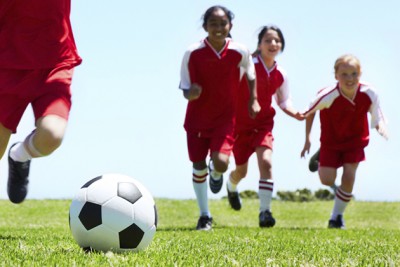
Getting young children involved in sports and other recreational activities is a great way to keep them healthy, happy, and fit. But being active also increases a child’s chances of getting hurt. Each year, more than 3.5 million children ages 14 and under receive medical treatment for sports-related injuries, according to Safe Kids USA, a national nonprofit organization dedicated to preventing injuries to children.
At UConn, Lindsay DiStefano, assistant professor of kinesiology in the Neag School of Education, is studying ways to protect these young athletes from injury. DiStefano, a certified athletic trainer with expertise in lower-body mechanics, is currently working with several hundred young Connecticut soccer players as part of study supported by a $150,000 grant from the Charles H. Hood Foundation.
DiStefano wants to see whether special warm-ups and exercises might help prevent sports-related injuries in middle-school children 14 years of age and younger.
“Millions of children participate in organized sports and the rate of youth sports-related injuries, such as anterior cruciate ligament (ACL) sprains, is rising,” says DiStefano. “Much of the research to date has focused on preventing injuries in the high school and adult populations because injury risk is greatest in adolescents aged 15 to 17. This study looks at children younger than 15, where we believe early intervention and an understanding of preventative approaches can significantly reduce the risks.”
As part of her research study, DiStefano is working with 400 children – 200 boys and 200 girls – participating in a youth soccer program in the town of South Windsor, Conn. Teams were randomly selected to take part in a specially-developed prevention program, a traditional injury prevention program, or a control group. Each group is participating in the warm-ups prior to soccer for eight weeks. Participants will then be evaluated on the way they land when they jump, and how well they maintain their balance before and after the program. They will be evaluated again two and four months later, to see how much information is retained and whether follow-up training is necessary.
Sports-related injuries, even at a young age, can lead to re-injuries, osteoarthritis, and future decreased activity. Sprains (mostly of the ankle) account for the most common injuries, followed by muscle strains, bone injuries, repetitive motion injuries, and heat-related illness. Preventing only 10 percent of youth sport-related injuries potentially saves $4.9 billion annually in immediate health care costs, DiStefano says, citing a Safe Kids USA sports and recreation safety report from 2011.
While early intervention and awareness is important for all children active in sports, it is particularly important for young girls, who are eight times more likely to experience an ACL injury than boys, according to statistics. The anterior cruciate ligament keeps the knee stable. ACL injuries often require surgery and a lengthy recovery time.
Many of the lower extremity injuries that are being reported are preventable with the right kind of preparation and prevention, says DiStefano, who is also a principal investigator with UConn’s Center for Health, Intervention, and Prevention (CHIP). Injury prevention activities focusing on movement and balance techniques and performed as a 15-minute warm-up can improve neuromuscular control and the way an individual controls his or her body, DiStefano says. Studies show that improving neuromuscular control and gaining better body control – by learning to flex a knee properly, land safely after jumping, and generally maintain proper balance – reduces ACL and other lower extremity injury risk by 50 percent to 70 percent.
“Implementing injury prevention programs to young children in the early stages of organized sport has potential for making these programs the social norm by the time children reach adolescence, which is when the highest risk of injury occurs,” DiStefano says. “While a specialized, more simplified program may be required for younger children, implementing injury prevention programs for a middle school population is ideal for optimizing long-term adoption of the program.”
DiStefano’s expertise in injury prevention and lower extremity injuries is nationally known. She is currently participating in one of the largest prospective federally-funded studies in sports medicine to identify risk factors for lower extremity injuries in military personnel. UConn kinesiology professor Douglas Casa, director of athletic training education, said he is “absolutely certain that Dr. DiStefano is one of the top five young researchers currently working within the athletic training profession nationally.”
 Facebook
Facebook
 Twitter
Twitter
 LinkedIn
LinkedIn
